Adaptive Event-Triggered Synchronization of Uncertain Fractional Order Neural Networks with Double Deception Attacks and Time-Varying Delay
Abstract
:1. Introduction
- (1)
- The synchronization problem of FNNs under network attacks is firstly proposed with an AETS to further save network bandwidth resources. The AETS has an adaptive law for adjusting its threshold coefficient such that the controller can timely access system information to stabilize the error system.
- (2)
- A generalized deception attack for FNNs is investigated; that is, the deception attack may occur in S-C and C-A channels simultaneously. Moreover, the attack behaviors are governed by independent Markov processes that are more extensive than the Bernoulli processes in other studies.
- (3)
- Parameters’ uncertainties and time-varying delay are also investigated in light of the synchronization problem of FNNs and a double deception attack in the AETS. That is more practicable to some extent.
2. Preliminaries and Model Formulation
2.1. Fractional Order Calculations
- (1)
- , where
- (2)
- , where C is a constant.
- (3)
- , where and are any constants.
2.2. Model Formulation
3. Results
4. Numerical Simulations
5. Discussion and Conclusions
Author Contributions
Funding
Institutional Review Board Statement
Informed Consent Statement
Data Availability Statement
Conflicts of Interest
Abbreviations
| FNNs | Fractional order neural networks |
| ETS | Event-triggered scheme |
| TTS | Time-triggered scheme |
| AETS | Adaptive event-triggered scheme |
| S-C Channel | Sensor to controller channel |
| C-A Channel | Controller to actuator channel |
References
- Wang, Y.; Guo, J.; Liu, G.B.; Lu, J.W. Finite-time sampled-data synchronization for uncertain neutral-type semi-Markovian jump neural networks with mixed time-varying delays. Appl. Math. Comput. 2021, 403, 126197. [Google Scholar]
- Ding, S.B.; Wang, Z.S.; Rong, N.N. Intermittent control for quasi synchronization of delayed discrete-time neural networks. IEEE Trans. Cybern. 2021, 51, 862–873. [Google Scholar] [CrossRef] [PubMed]
- Tian, Y.F.; Wang, Z.S. A new result on H∞ performance state estimation for static neural networks with time-varying delays. Appl. Math. Comput. 2021, 388, 125556. [Google Scholar] [CrossRef]
- Yuan, M.M.; Wang, W.P.; Wang, Z. Exponential synchronization of delayed memristor-based uncertain complex-valued neural networks for image protection. IEEE Trans. Neural Netw. Learn. Syst. 2020, 99, 1–15. [Google Scholar] [CrossRef] [PubMed]
- Xi, H.L.; Li, Y.X.; Huang, X. Generation and nonlinear dynamical analyses of fractional-order memristor-based lorenz systems. Entropy 2014, 16, 6240–6253. [Google Scholar] [CrossRef] [Green Version]
- Sun, H.G.; Yong, Z.; Baleanu, D.; Chen, Y.Q. A new collection of real world applications of fractional calculus in science and engineering. Commun. Nonlinear Sci. Numer. Simul. 2018, 64, 213. [Google Scholar] [CrossRef]
- Vladimir, Z.; Ilya, K. Best approximation of the fractional semi-derivative operator by exponential series. Mathematics 2018, 6, 12. [Google Scholar]
- Chen, L.P.; Qu, J.F.; Chai, Y. Synchronization of a class of fractional-order chaotic neural networks. Entropy 2013, 15, 3265–3276. [Google Scholar] [CrossRef]
- Cao, J.D.; Stamov, G.; Stamova, I. Almost periodicity in impulsive fractional-order reaction-diffusion neural networks with time-varying delays. IEEE Trans. Cybern. 2020, 51, 151–161. [Google Scholar] [CrossRef]
- Jia, J.; Huang, X.; Li, Y.X.; Cao, J.D. Global stabilization of fractional-order memristor-based neural networks with time delay. IEEE Trans. Neural Netw. Learn. Syst. 2020, 31, 997–1009. [Google Scholar] [CrossRef]
- Xiao, J.Y.; Cao, J.D.; Cheng, J. Novel methods to finite-time Mittag–Leffler synchronization problem of fractional-order quaternion-valued neural networks. Inf. Sci. 2020, 526, 221–244. [Google Scholar] [CrossRef]
- Hu, H.P.; Wang, J.K.; Xie, F.L. Dynamics analysis of a new fractional-order hopfield neural network with delay and its generalized projective synchronization. Entropy 2019, 21, 1. [Google Scholar] [CrossRef] [Green Version]
- Wu, Y.B.; Zhu, J.L.; Li, W.X. Intermittent discrete observation control for synchronization of stochastic neural networks. IEEE Trans. Cybern. 2020, 50, 2414–2424. [Google Scholar] [CrossRef]
- Cao, Y.T.; Wang, S.B.; Guo, Z.Y.; Huang, T.W. Synchronization of memristive neural networks with leakage delay and parameters mismatch via event-triggered control. Neural Netw. 2019, 119, 178–189. [Google Scholar] [CrossRef]
- Rakkiyappan, R.; Dharani, S.; Cao, J.D. Synchronization of neural networks with control packet loss and time-varying delay via stochastic sampled-data controller. IEEE Trans. Neural Netw. Learn. Syst. 2015, 26, 3215–3226. [Google Scholar] [CrossRef]
- Dai, M.C.; Xia, J.W.; Xia, H.; Shen, H. Event-triggered passive synchronization for Markov jump neural networks subject to randomly occurring gain variations. Neurocomputing 2019, 33, 403–411. [Google Scholar] [CrossRef]
- Shanmugam, L.; Mani, P.; Rajan, R. Adaptive synchronization of reaction-diffusion neural networks and its application to secure communication. IEEE Trans. Cybern. 2020, 50, 911–922. [Google Scholar] [CrossRef]
- Hu, T.T.; He, Z.; Zhang, X.J.; Zhong, S.M. Leader-following consensus of fractional-order multi-agent systems based on event-triggered control. Nonlinear Dyn. 2020, 99, 2219–2232. [Google Scholar] [CrossRef]
- Cheng, Y.L.; Hu, T.T.; Li, Y.H.; Zhong, S.M. Consensus of fractional-order multi-agent systems with uncertain topological structure: A Takagi-Sugeno fuzzy event-triggered control strategy. Fuzzy Sets Syst. 2021, 416, 64–85. [Google Scholar] [CrossRef]
- Wei, M.; Li, Y.X.; Tong, S. Event-triggered adaptive neural control of fractional-order nonlinear systems with full-state constraints. Neurocomputing 2020, 412, 320–326. [Google Scholar] [CrossRef]
- Li, Q.P.; Liu, S.Y.; Chen, Y.G. Combination event-triggered adaptive networked synchronization communication for nonlinear uncertain fractional-order chaotic systems. Appl. Math. Comput. 2018, 333, 521–535. [Google Scholar] [CrossRef]
- Xiong, M.H.; Tan, Y.S.; Zhang, B.Y.; Fei, S.M. Observer-based event-triggered output feedback control for fractional-order cyber–physical systems subject to stochastic network attacks. ISA Trans. 2020, 104, 15–25. [Google Scholar] [CrossRef] [PubMed]
- Yu, N.X.; Zhu, W. Event-triggered impulsive chaotic synchronization of fractional-order differential systems. Appl. Math. Comput. 2021, 388, 125554. [Google Scholar] [CrossRef]
- Zouad, F.; Kemih, K.; Hamiche, H. A new secure communication scheme using fractional order delayed chaotic system: Design and electronics circuit simulation. Analog Integr. Circ. Signal Process. 2019, 99, 619–632. [Google Scholar] [CrossRef]
- Bettayeb, M.; Said, D. Single channel secure communication scheme based on synchronization of fractional-order chaotic chua’s systems. Trans. Inst. Meas. Control 2018, 40, 3651–3664. [Google Scholar] [CrossRef]
- Zhao, C.C.; Duan, X.M.; Cai, L.; Cheng, P. Vehicle platooning with non-ideal communication networks. IEEE Trans. Veh. Technol. 2021, 70, 18–32. [Google Scholar] [CrossRef]
- Petrillo, A.; Pescape, A.; Santini, S. A collaborative approach for improving the security of vehicular scenarios: The case of platooning. Comput. Commun. 2018, 122, 59–75. [Google Scholar] [CrossRef]
- Wang, Z.B.; Song, M.K.; Zheng, S.Y. Invisible adversarial attack against deep neural networks: An adaptive penalization approach. IEEE Trans. Dependable Secur. Comput. 2021, 18, 1474–1488. [Google Scholar] [CrossRef]
- Rahman, R.; Tomar, D. Threats of price scraping on e-commerce websites: Attack model and its detection using neural network. J. Comput. Virol. Hacking Tech. 2021, 17, 75–89. [Google Scholar] [CrossRef]
- Deng, Z.; Lun, X.; Yu, R. Data security transmission mechanism in industrial neural control systems against deception attack. Int. J. Secur. Appl. 2016, 10, 391–404. [Google Scholar]
- Shen, B.; Wang, Z.D.; Wang, D.; Li, Q. State-saturated recursive filter design for stochastic time-varying nonlinear complex networks under deception attacks. IEEE Trans. Neural Netw. Learn. Syst. 2020, 31, 3788–3800. [Google Scholar] [CrossRef]
- Pan, R.Q.; Tan, Y.S.; Du, D.S. Adaptive event-triggered synchronization control complex networks with quantization and cyber-attacks. Neurocomputing 2020, 382, 249–258. [Google Scholar] [CrossRef]
- Liu, J.L.; Xia, J.L.; Cao, J.; Tian, E.G. Quantized state estimation for neural networks with cyber attacks and hybrid triggered communication scheme. Neurocomputing 2018, 291, 35–49. [Google Scholar] [CrossRef]
- Sun, Y.M.; Yu, J.Y.; Yu, X.H.; Gao, H.J. Decentralized adaptive event-triggered control for a class of uncertain systems with deception attacks and its application to electronic circuits. IEEE Trans. Circ. Syst. 2020, 67, 12. [Google Scholar] [CrossRef]
- Song, Q.K.; Shu, H.Q.; Zhao, Z.J.; Liu, Y.R. Lagrange stability analysis for complex-valued neural networks with leakage delay and mixed time-varying delays. Neurocomputing 2017, 244, 33–41. [Google Scholar] [CrossRef]
- Peng, C.; Han, Q.L.; Yue, D. Communication delay distribution dependent decentralized control for large-scale systems with IP-based communication networks. IEEE Trans. Control Syst. Technol. 2013, 21, 820–830. [Google Scholar] [CrossRef]
- Chen, G.R.; Zhou, J.; Liu, Z.R. Global synchronization of couple delayed neural networks and applications to chaotic cnn models. Int. J. Bifurc. Chaos 2004, 14, 2229–2240. [Google Scholar] [CrossRef]
- Yu, W.W.; Cao, J.D. Synchronization control of stochastic delayed neural networks. Phys. A 2007, 373, 252–260. [Google Scholar] [CrossRef]
- Vijay Aravind, R.; Balasubramaniam, P. Stochastic stability of fractional-order Markovian jumping complex-valued neural networks with time-varying delays. Neurocomputing 2021, 439, 122–133. [Google Scholar] [CrossRef]
- Tian, J.K.; Li, Y.M.; Zhao, J.; Zhong, S. Delay-dependent stochastic stability criteria for Markovian jumping neural networks with mode-dependent time-varying delays and partially known transition rates. Appl. Math. Comput. 2012, 218, 5769–5781. [Google Scholar] [CrossRef]
- Balasubramaniam, P.; Rakkiyappan, R. Delay-dependent robust stability analysis for Markovian jumping stochastic Cohen–Grossberg neural networks with discrete interval and distributed time-varying delays. Nonlinear Anal. Hybrid Syst. 2009, 3, 207–214. [Google Scholar] [CrossRef]
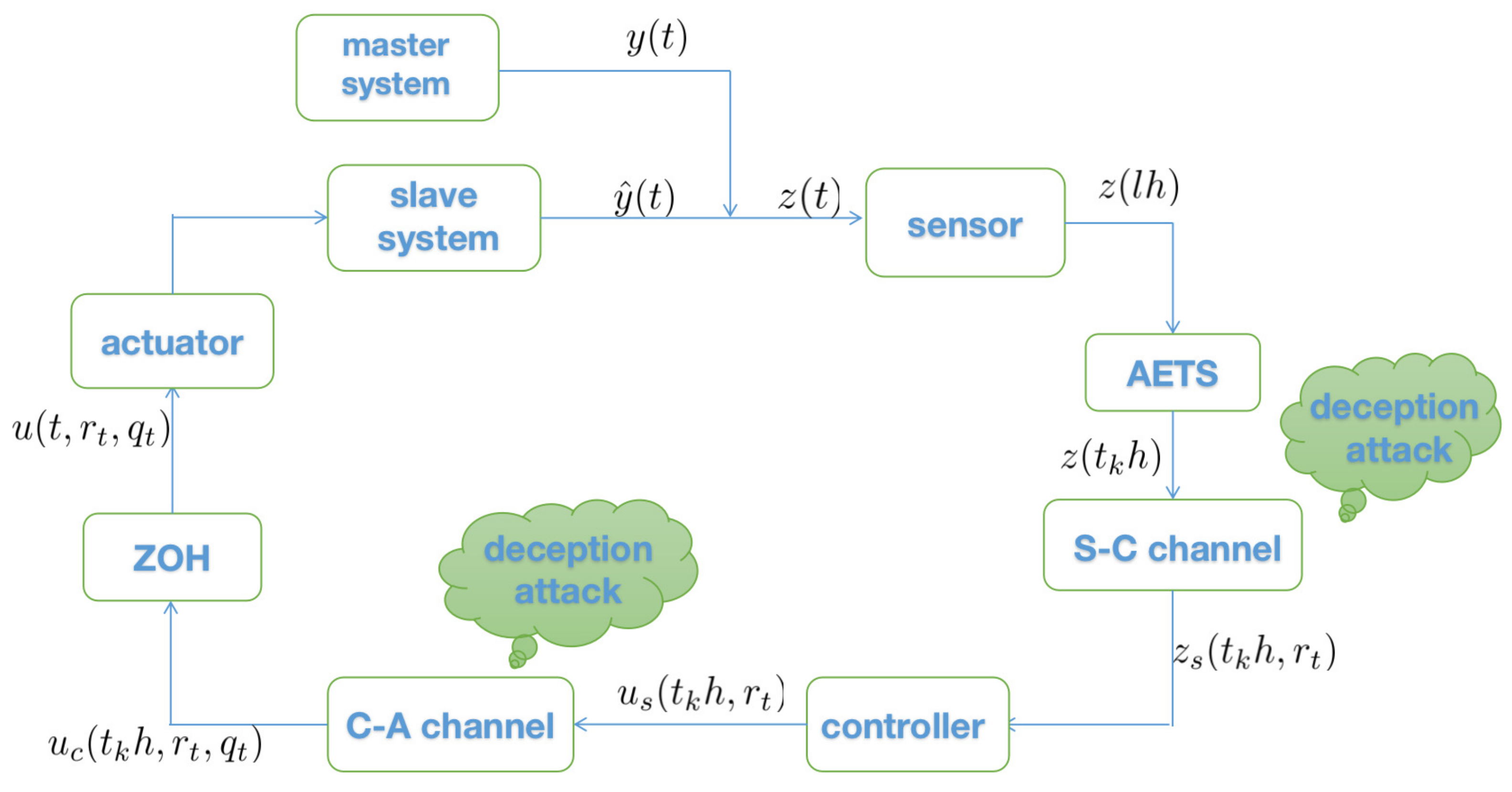
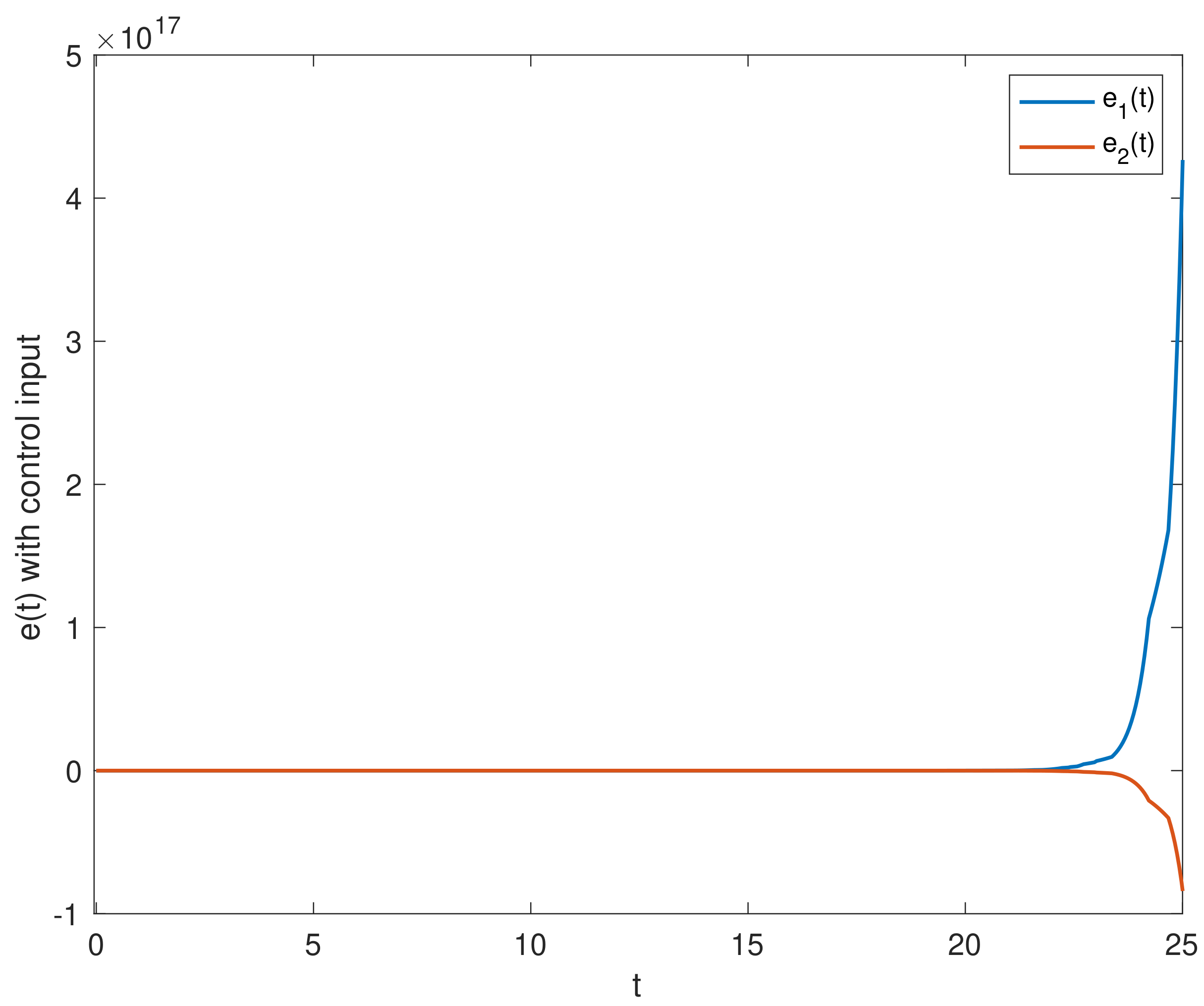
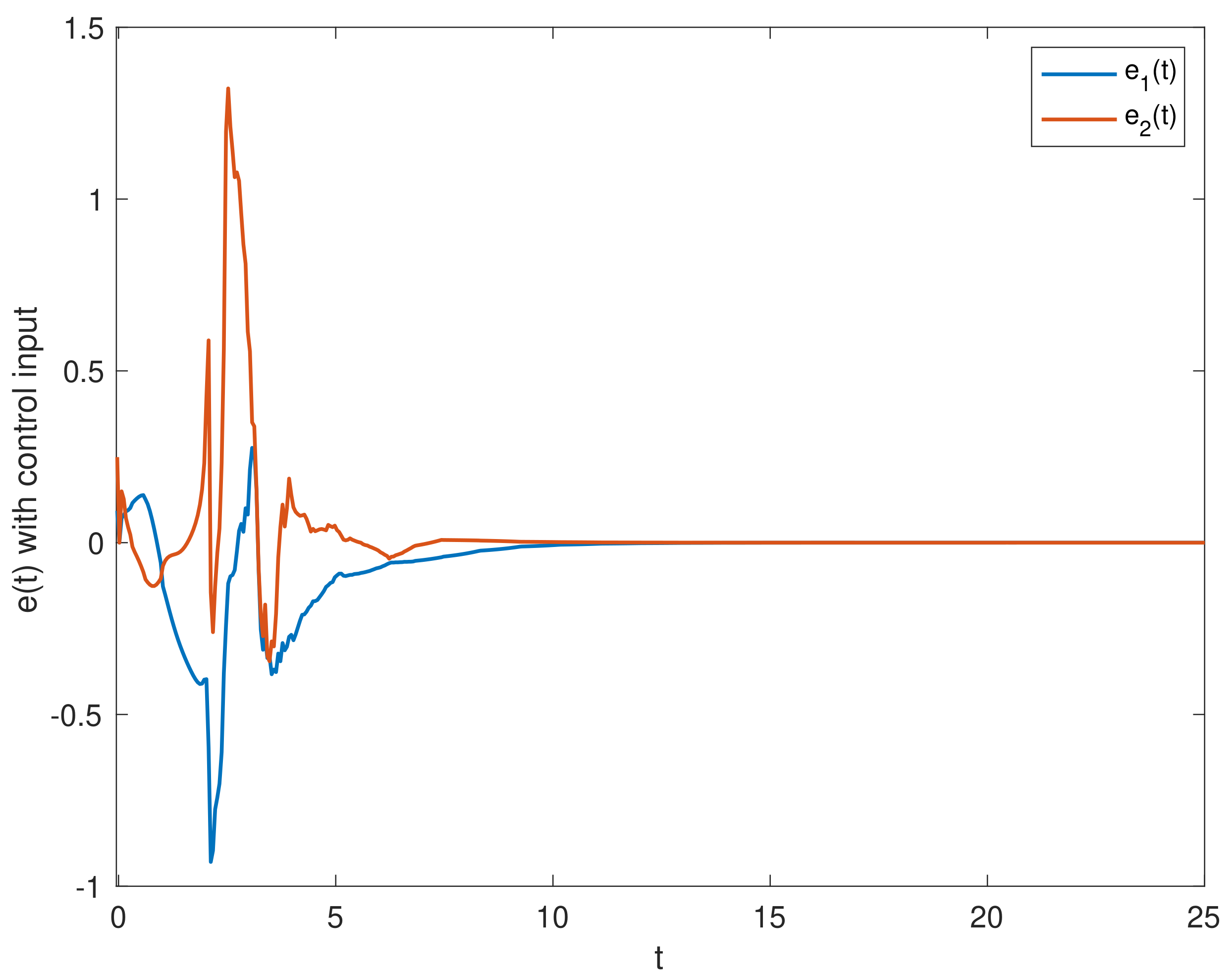
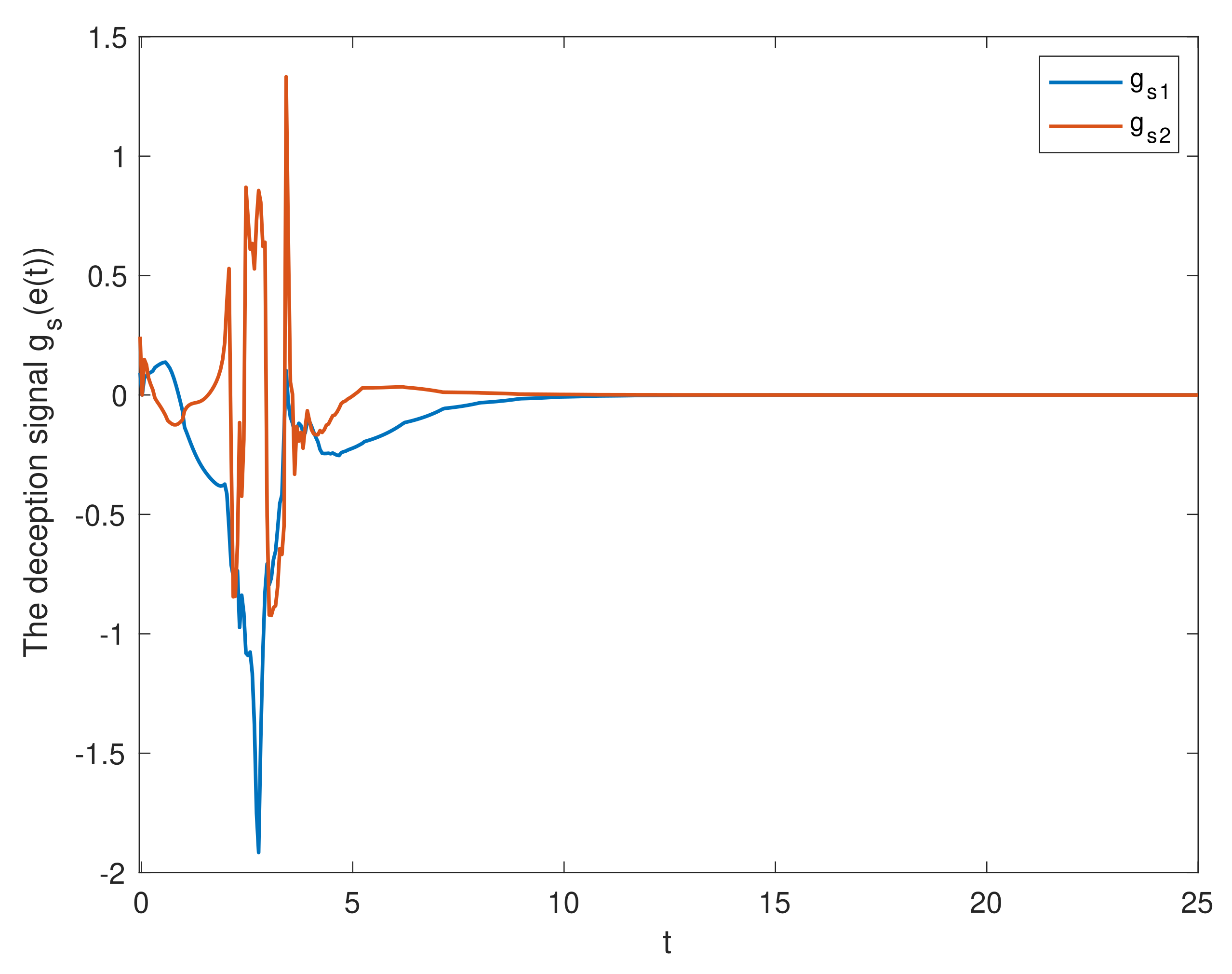
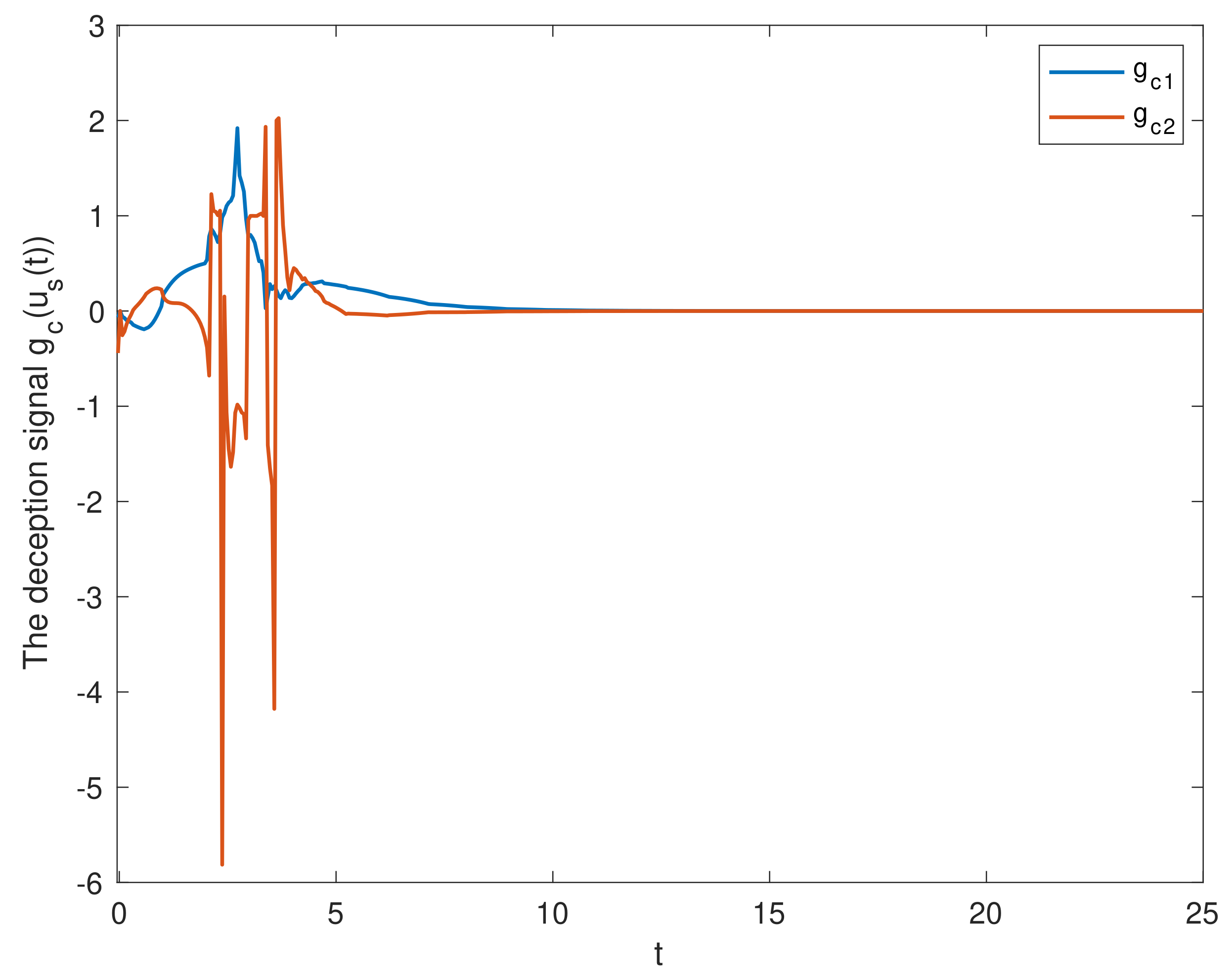
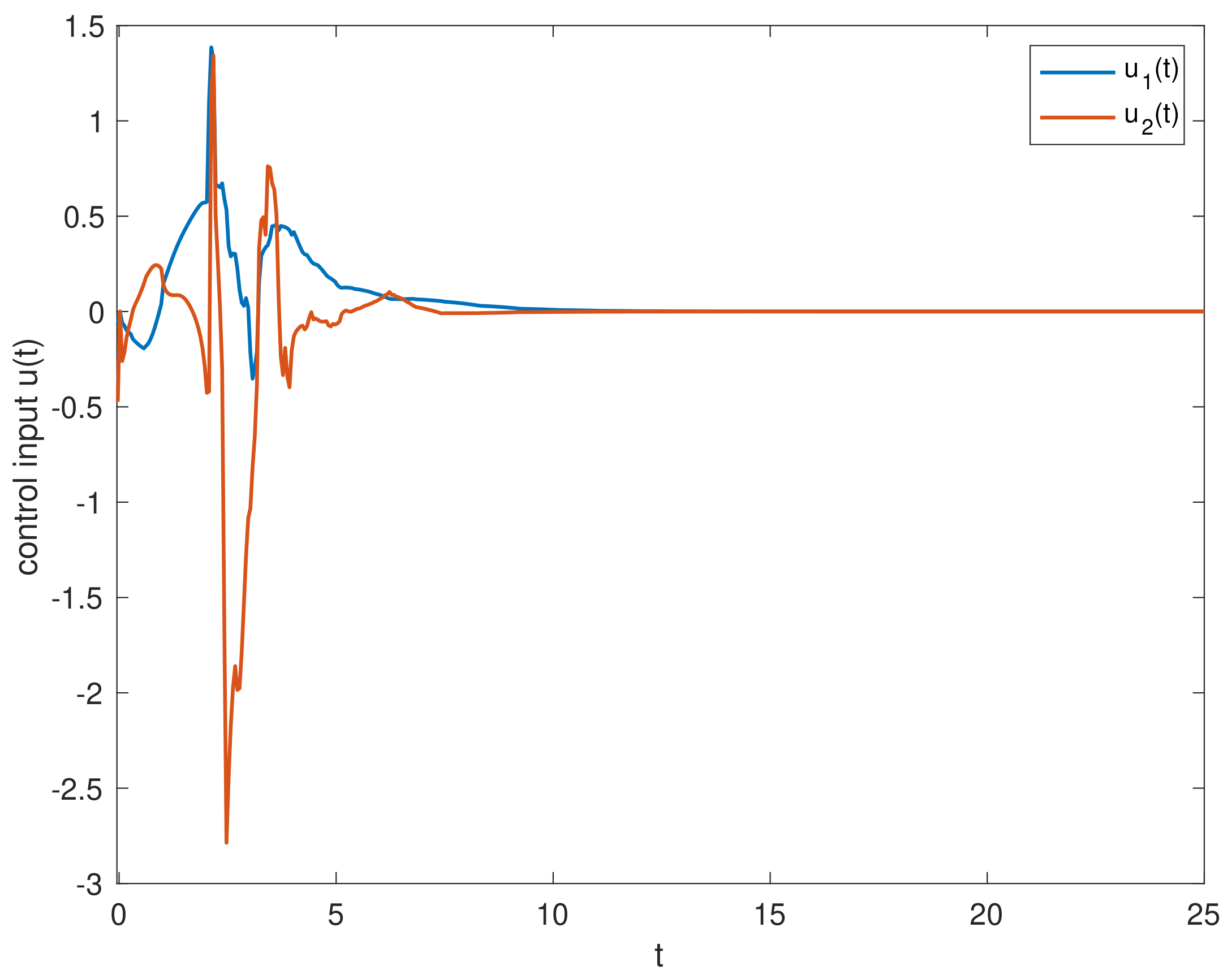
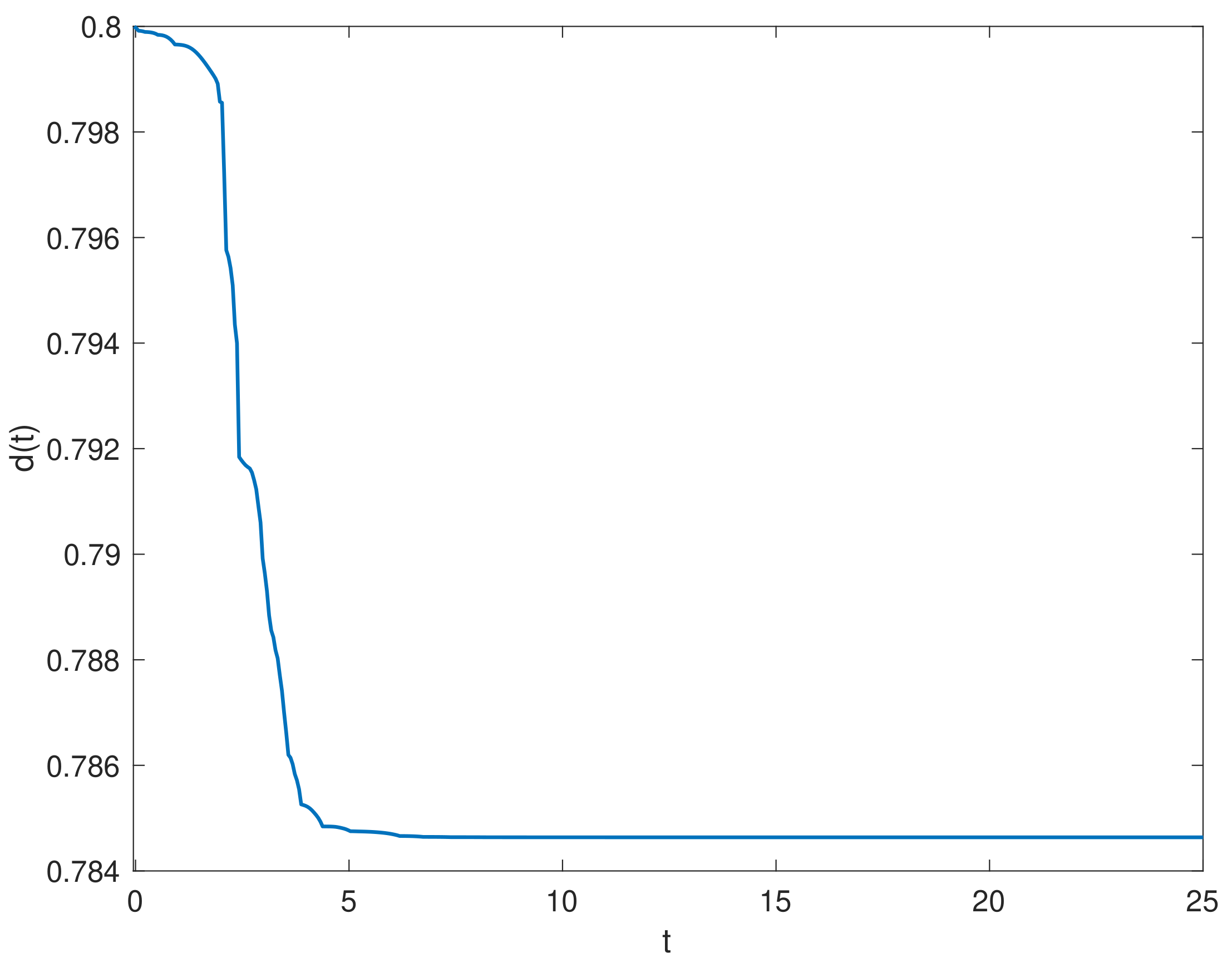
Publisher’s Note: MDPI stays neutral with regard to jurisdictional claims in published maps and institutional affiliations. |
© 2021 by the authors. Licensee MDPI, Basel, Switzerland. This article is an open access article distributed under the terms and conditions of the Creative Commons Attribution (CC BY) license (https://creativecommons.org/licenses/by/4.0/).
Share and Cite
Shen, Z.; Yang, F.; Chen, J.; Zhang, J.; Hu, A.; Hu, M. Adaptive Event-Triggered Synchronization of Uncertain Fractional Order Neural Networks with Double Deception Attacks and Time-Varying Delay. Entropy 2021, 23, 1291. https://doi.org/10.3390/e23101291
Shen Z, Yang F, Chen J, Zhang J, Hu A, Hu M. Adaptive Event-Triggered Synchronization of Uncertain Fractional Order Neural Networks with Double Deception Attacks and Time-Varying Delay. Entropy. 2021; 23(10):1291. https://doi.org/10.3390/e23101291
Chicago/Turabian StyleShen, Zhuan, Fan Yang, Jing Chen, Jingxiang Zhang, Aihua Hu, and Manfeng Hu. 2021. "Adaptive Event-Triggered Synchronization of Uncertain Fractional Order Neural Networks with Double Deception Attacks and Time-Varying Delay" Entropy 23, no. 10: 1291. https://doi.org/10.3390/e23101291
APA StyleShen, Z., Yang, F., Chen, J., Zhang, J., Hu, A., & Hu, M. (2021). Adaptive Event-Triggered Synchronization of Uncertain Fractional Order Neural Networks with Double Deception Attacks and Time-Varying Delay. Entropy, 23(10), 1291. https://doi.org/10.3390/e23101291





